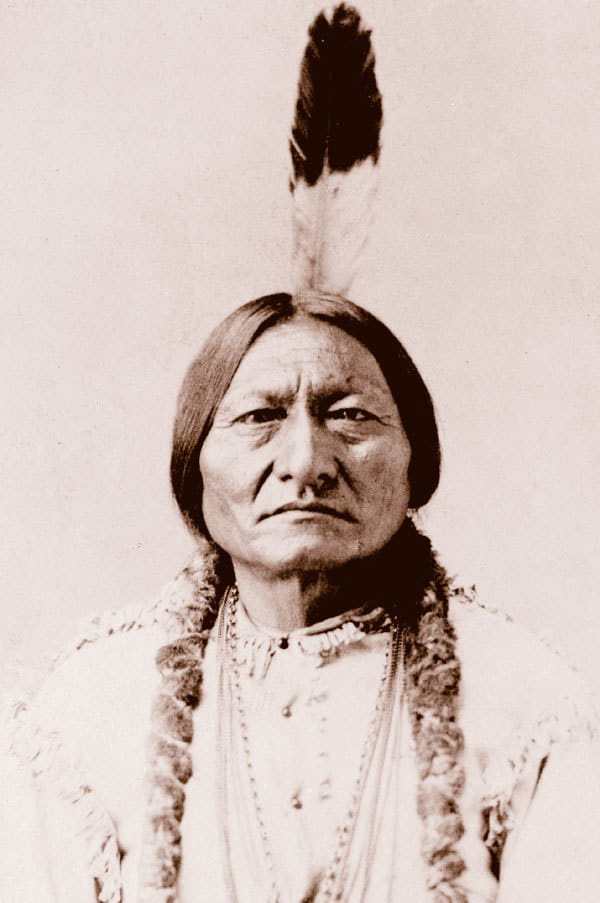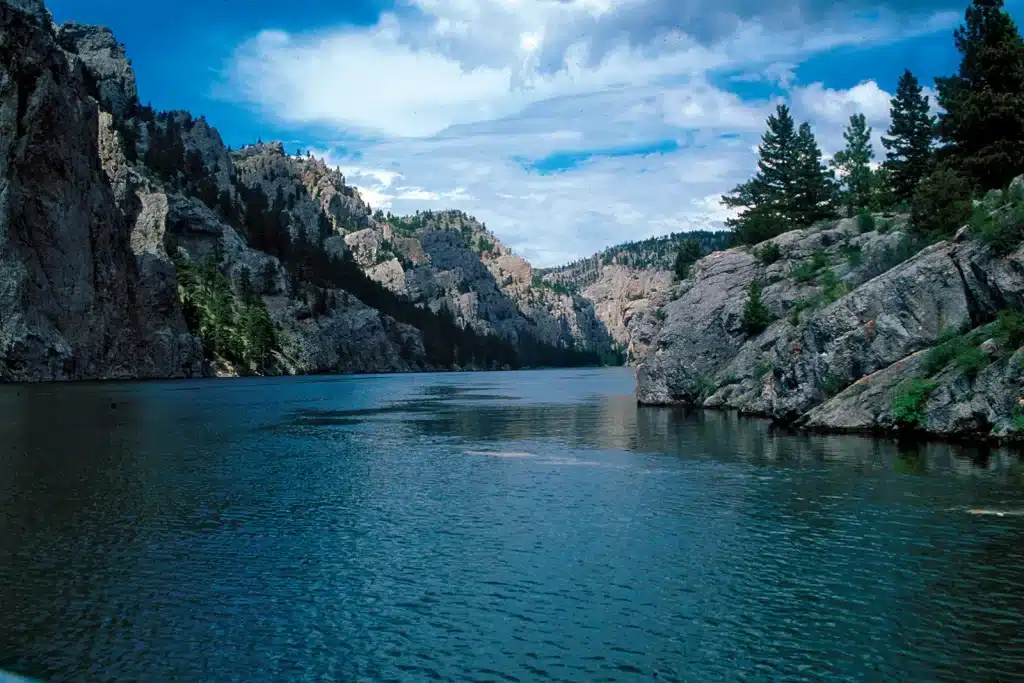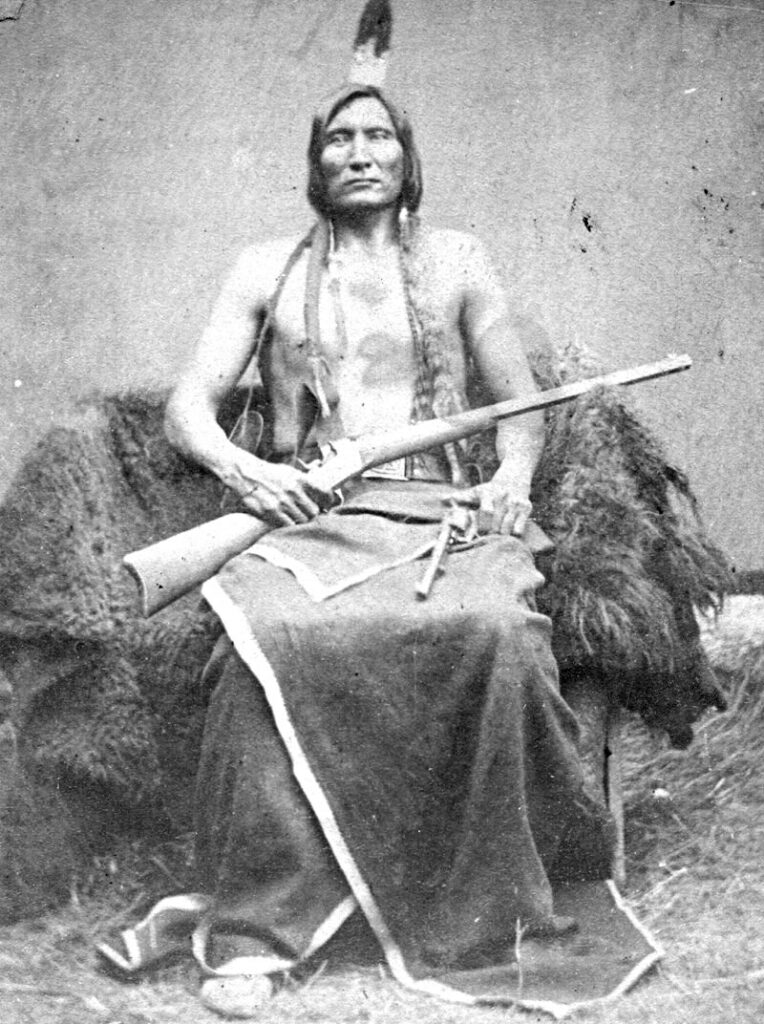The Lakota tribe was one of the three Sioux tribes of the Plains. They played a key role in the development of the West as they fought to keep their lands.

There were many famous warriors who came from the Lakota tribe, and they fought valiantly for their freedom. They are one of the most well-known Native American Tribes in Native American History.
Early History

The Sioux-speaking people probably originated near the lower Mississippi River region and then migrated towards the Ohio Valley. They may have been a part of the Mound Builder civilization during the 9th-12th centuries.
By the time of the 16th and 17th centuries, the Lakota tribe lived in the upper Mississippi Region in the present-day states of Minnesota, Wisconsin, Iowa, and the Dakotas.
Conflicts with other tribes pushed them west towards the Great Plains.
The Early Lakota people kept a record of their history with Winter counts. These were pictorial calendars painted on hides and later put on paper.
The Lakota tribe would become known for their excellent horseback riding during the 19th century. However, the early Lakota people did not ride horses. Horses were not native to America and came from Europe.
The Cheyenne people introduced the Lakota tribe to horses in the early 18th century. This changed their culture and hunting considerably.
The Lakota people then became a horse culture and soon were excellent riders. They hunted the buffalo on horseback as well as in other games.
They became efficient with the bow while riding the horse, which made them deadly during wartime.
After 1720, the Lakota branch of the Seven Council Fires split into two major sects: the Saône, who moved to the Lake Traverse area on the South Dakota–North Dakota–Minnesota border, and the Oglála-Sičháŋǧu who occupied the James River valley.
However, by about 1750, the Saône had moved to the east bank of the Missouri River, followed 10 years later by the Oglála and Brulé.
The large and powerful Arikara, Mandan, and Hidatsa villages had long prevented the Lakota from crossing Missouri.

However, the great smallpox epidemic of 1772–1780 destroyed three-quarters of these tribes. The Lakota crossed the river into the drier, short-grass prairies of the High Plains.
These newcomers were the Saône, well-mounted and increasingly confident, who spread out quickly.
In 1765, a Saône exploring and raiding party led by Chief Standing Bear discovered the Black Hills (the Paha Sapa), then the territory of the Cheyenne. Ten years later, the Oglála and Brulé also crossed the river.
In 1776, while America was fighting for freedom from Britain, the Lakota defeated the Cheyenne, who had earlier taken the region from the Kiowa.
The Cheyenne then moved west to the Powder River country, and the Lakota made the Black Hills their home.
19th Century
The first time that the Lakota Tribe came into contact with the United States was during the Lewis and Clark Expedition.
It was not a pleasant first impression as the Lakota people refused to allow the explorers to continue upstream.
The next time the Lakota show up in American History was during the Arikara War in 1823.
As the Americans continued to migrate to the Wild West, they began to experience and even participate in various Indian Wars. In 1843, the southern Lakotas attacked Pawnee Chief Blue Coat's village near Loup in Nebraska. They killed many people and burned half of the earth's lodges.
Western Migration
Fort Laramie had been constructed as a fur trading post in the early 19th century and eventually was repurposed into a fort. It served as protection for settlers heading on the Oregon Trail, California Gold Rush, and Mormon Trail.
However, the fort had been constructed on Lakota land, and as American migration pushed further west, the Lakota and Cheyenne tribes became more aggressive.
The United States, Lakota, and Cheyenne signed the Fort Laramie Treaty that acknowledged Lakota sovereignty over the Great Plains in exchange for free passage on the Oregon Trail for "as long as the river flows and the eagle flies."
However, the United States had little intention of enforcing that and allowed settlers to settle in unauthorized lands at their own risk.
This enraged the Lakota, and they began attacking settlers and even emigrant trains. This began to put a lot of political pressure on the United States government to punish the Lakota tribe for their aggression.
On September 3, 1855, 700 soldiers under General William S. Harney avenged the Grattan Massacre (29 soldiers along with their officers were killed) by attacking a Lakota village in Nebraska, killing about 100 men, women, and children.
Some short wars followed, but by 1861, the United States was embroiled in the Civil War. This increased the number of illegal settlements out west.
Post-Civil War
The Lakota did not get involved in the Civil War, and as soon as the war ended, Americans began pushing west again. The Railroad was being built, and Americans were moving across the country faster than they ever had in the past.
The Black Hills had valuable resources that the United States wanted to mine, but the Lakota people considered the area sacred and objected to any mining.
The U.S. Army fought the Lakota and their allies along the Bozeman Trail and was ultimately defeated in Red Cloud's War.
The United States signed the Fort Laramie Treaty of 1868, exempting the Black Hills from settlement forever. However, gold was discovered on the land four years later, and prospectors and gold miners began descending on the area.
This ignited another conflict, and the U.S. Government sent the military under General Philip Sheridan to take care of the problem. Sheridan began to attack and destroy the buffalo as a means of "destroying the Indians' commissary."
The allied Lakota and Arapaho bands and the unified Northern Cheyenne were involved in much of the warfare after 1860.
They fought a successful delaying action against General George Crook's army at the Battle of the Rosebud, preventing Crook from locating and attacking their camp, and a week later, defeated the U.S. 7th Cavalry in 1876 at the Battle of the Greasy Grass in the Crow Indian Reservation of 1868.
General George Armstrong Custer, who had become famous for his slaughter of Indians, attacked a camp of several tribes.
He underestimated the size of their camp and ended up being defeated and killed at the Battle of the Little Bighorn.

Morale rose for the Native Americans, but it would be short-lived as the U.S. Army simply overwhelmed them.
They continued to reinforce the army and began a series of battles with the Lakotas that would shrink their numbers and leave them powerless, finally ending the Great Sioux War in 1877.
The Lakota were then moved to reservations.
Late 19th Century
In 1877, some of the Lakota bands signed a treaty that ceded the Black Hills to the United States; however, the nature of this treaty and its passage were controversial.

The number of Lakota leaders who actually backed the treaty is highly disputed. Low-intensity conflicts continued in the Black Hills.
Fourteen years later, Sitting Bull was killed at the Standing Rock reservation on December 15, 1890.
The U.S. Army attacked Spotted Elk (aka Bigfoot), the Mnicoujou band of Lakota, at the Wounded Knee Massacre on December 29, 1890, at Pine Ridge.
Today, the Lakota are found mostly in the five reservations of western South Dakota:
- Rosebud Indian Reservation, home of the Upper Sičhánǧu or Brulé.
- Pine Ridge Indian Reservation, home of the Oglála.
- Lower Brule Indian Reservation, home of the Lower Sičhaŋǧu.
- Cheyenne River Indian Reservation, home of several other of the seven Lakota bands, including the Mnikȟówožu, Itázipčho, Sihásapa, and Oóhenumpa.
- Standing Rock Indian Reservation, home of the Húŋkpapȟa and to people from many other bands.
Lakota also live on the Fort Peck Indian Reservation in northeastern Montana, the Fort Berthold Indian Reservation in northwestern North Dakota, and several small reserves in Saskatchewan and Manitoba. Their ancestors fled to "Grandmother's [i.e. Queen Victoria's] Land" (Canada) during the Minnesota or Black Hills War.
Large numbers of Lakota live in Rapid City and other towns in the Black Hills and in metro Denver. Lakota elders joined the Unrepresented Nations and Peoples Organization (UNPO) to seek protection and recognition for their cultural and land rights.
